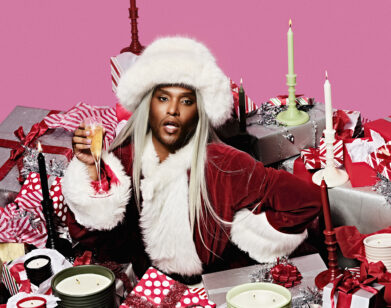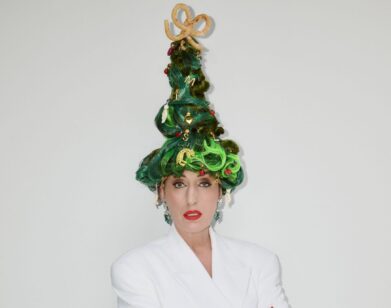With Menswear, Cynthia Rowley Shares Bill Powers’s Secrets

This fall, designer Cynthia Rowley launched Mr. Powers, a menswear line inspired by Bill Powers: owner of Half Gallery, judge on Bravo’s Work of Art, and her husband. Set to debut around the same time that the second season began in October, this new waist-up only collection of blazers and jackets has been modeled by none other than Mr. Powers every week on Work of Art, which will air its final episode at the end of this month.
Interview moderated a conversation between the Rowley and Powers to find out more about the impetus for the project, art vs. fashion, and what it’s like for the couple to work as a couple.
YASHA WALLIN: How did the idea of the menswear line Mr. Powers come about?
CYNTHIA ROWLEY: I guess it was sort of by popular demand. Last year when Bill was on Work of Art he was wearing all this stuff that we had made and everybody kept asking about it. We decided we should go full speed ahead with menswear. So, this year, as the show was taping—we actually planned ahead and figured out that he should wear certain things available in the store and online, so when you’re watching the show you can actually buy what he’s wearing.
BILL POWERS: You used to make more men’s stuff, and you were nominated for a CFDA award [for it]. Then when we started dating, I started to discourage you from making a lot more men’s clothes because I’d be wearing something and…
ROWLEY: …three other people would be wearing the same thing.
POWERS: We’d go to something and Alan Cumming would have the same jacket on, which is fine but…
ROWLEY: He’s wearing it without a shirt.
POWERS: Anyway, why are we doing [Mr. Powers] only “from the waist up?” At one point, you were going to call it “From the Waist Up,” right?
ROWLEY: Right. I just think that no guy buys an entire outfit, and no guy says, “I’m going to buy these bottoms and this top.” You know, guys don’t shop like that. They buy a shirt they like; they buy a T-shirt they like; they might buy a sweater or a jacket, but they never buy a “look.” And guys always wear jeans, which I think looks best anyways.
POWERS: There’s a pink jacket in the Mr. Powers collection—do you think that could be harder for a guy to pull off?
ROWLEY: The whole point is that colors that are harder to wear, less expected, or maybe not as commercial; if they’re used in the right way, they can make a design way more compelling, especially in menswear where color isn’t often used. I think it’s really exciting to have a lot of color in men’s stuff.
POWERS: I always liked the Glenn O’Brien line, “I used to be in fashion, but then I made bail.” Do you ever feel like that? Or are you still in a holding area?
ROWLEY: I feel like maybe I’m just on parole? Good behavior maybe? Maybe bad behavior is better?
WALLIN: Bill, how has your style changed since the two of you have been together?
POWERS: Not that much. I have to wear glasses now, which I didn’t 10 years ago. I always like to be able to wake up in the morning and know that what I’m wearing can flow through the day to where I’m going and where I’ll end up. Most guys have a default uniform, and so as you get older you kind of figure out what your version of a uniform is, and I think for guys—at least for me—it’s wanting to find something that I can wear until it disintegrates. I try to find those pieces… it’s usually a jacket I wear with a t-shirt or a dress shirt. I have this jacket that you made that I like to wear that when you open it up it’s kind of singed from that go-kart accident. It’s cool that it has a secret history and like a sympathetic magic to it, it has a little of the real world in it.
ROWLEY: I always think clothing is like a scrapbook: you remember all the good memories and the past times. I know the jacket you’re talking about: we have a friend in the Dominican Republic that says “I’ll never forget the first time I laid eyes on Bill; he was walking down the beach wearing a swimsuit and a sport jacket and nothing else!” It’s that jacket.
POWERS: I had a shirt underneath!
ROWLEY: No you didn’t!
POWERS: Yes I did!
WALLIN: Who do you think are good male style icons?
POWERS: I like George Condo—not any actual piece of clothing, but he kind of conveys the sense of “down-on-his-luck aristocrat.”
WALLIN: How would you describe the personality of the Mr. Powers collection?
ROWLEY: I think it’s like a younger, world-weary eccentric.
POWERS: If you think of American style—it’s been co-opted by Ralph [Lauren] or Tommy [Hilfiger]—but there has to be something else to describe American style other than the white t-shirt. If you do a historical mash-up with, say, Tyler in Fight Club, the anarchist, and John Delorean, who, even though he died as a failure, people appreciated his spirit. So it’s kind of mixing up all those influences. I think sometimes it’s worth knowing what you can pull off. Andy Warhol said, “Art is what you can get away with,” and sometimes fashion is, too.
WALLIN: Bill, what do you think you’re going to wear the most from this collection?
POWERS: There’s this one pink jacket that I love, and a kind of darker blue checkered plaid, and a quilted black jacket. That’s the thing I like about New York. In New York, because there are real seasons it’s easier to compartmentalize time by thinking about what you’re wearing. It helps contextualize those timelines.
ROWLEY: I also think guys don’t shop according to season.
POWERS: Guys do emergency shopping.
ROWLEY: I think you kind of wear things year-round…
POWERS: People might not know Cynthia for her men’s fashion, but that’s cool to have little surprises out there. Most people won’t know that you were nominated for a CFDA award in menswear. When I go to an artist retrospective, you see this whole body of work that you’ve never known before. I think it’s cool to have little secrets embedded into your history, that’s the challenge: to still have some surprises up your sleeve.
ROWLEY: Hopefully, there are a lot!
POWERS: People have an idea in their head of what a designer is going to give them so if you can be a little subversive and still have a few unexpected things, while still maintaining your identity. That’s the challenge, right? How do you maintain your core identity? People know they’re coming to you for a certain idea of what or who you are and I think people follow artists like that too but that you’re still going to give them something outside the thing that they trust and love.
ROWLEY: Fashion went from being much more rarefied to being more accessible [with stores] like H&M. Now everything is changing in the art world, too: even the highest level of institutions are becoming more aware of the general public, like the McQueen exhibit at the Metropolitan or the Tim Burton at the MoMA or how the Gagosian does historic Picasso shows, bringing museum quality into a gallery. Galleries are becoming more like museums, and museums are becoming more accessible. I think that TV is embracing the art world more, and online art sales like Exhibition A embrace contemporary art and it’s all changing really fast. In the same way fashion changed, things are changing in the art world too. In the next decade, I think it’ll be blown open: there will be a lot of shifting around in terms of how artists approach their work.






